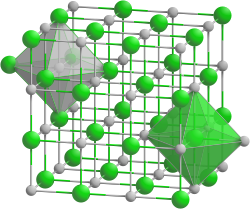Zirconium nitride
| Crystal structure | ||||||||||||||||
|---|---|---|---|---|---|---|---|---|---|---|---|---|---|---|---|---|

|
||||||||||||||||
| __ Zr 3+ __ N 3− | ||||||||||||||||
| General | ||||||||||||||||
| Surname | Zirconium nitride | |||||||||||||||
| other names |
|
|||||||||||||||
| Ratio formula | ZrN | |||||||||||||||
| Brief description |
yellow to brown odorless solid |
|||||||||||||||
| External identifiers / databases | ||||||||||||||||
|
||||||||||||||||
| properties | ||||||||||||||||
| Molar mass | 105.23 g mol −1 | |||||||||||||||
| Physical state |
firmly |
|||||||||||||||
| density |
7.09 g cm −3 |
|||||||||||||||
| Melting point |
2980 ° C |
|||||||||||||||
| solubility |
|
|||||||||||||||
| safety instructions | ||||||||||||||||
|
||||||||||||||||
| As far as possible and customary, SI units are used. Unless otherwise noted, the data given apply to standard conditions . | ||||||||||||||||
Zirconium nitride is an inorganic chemical compound of zirconium from the group of nitrides .
Extraction and presentation
Zirconium nitride can be prepared using the same methods as titanium nitride .
- Yellow-brown zirconium nitride is obtained from the synthesis from the elements at 1200 ° C.
- When producing zirconium nitride from zirconium (IV) chloride by the growth process , a lower temperature (2000 to 2400 ° C) is required in the presence of hydrogen (H 2 + N 2 or ammonia ) than in pure nitrogen (2900 ° C). In the latter case, the deposition takes place significantly more slowly than in the presence of hydrogen. By nitriding zirconium wires, i.e. H. By heating in pure nitrogen, even at a temperature just below the melting point of zirconium (1860 ° C), zirconium nitride is obtained only very slowly and, moreover, in a highly loosened, brittle state.
- At relatively low temperatures, defined zirconium nitride phases can be obtained by ammonolysis of zirconium halides , in particular of zirconium (IV) iodide, via the intermediate stage zirconium nitride iodide ZrNI. At 700 ° C mainly brown Zr 3 N 4 forms (o-Zr 3 N 4 with a density of 6.32 g / cm 3 and the space group Pnam), at 750 ° C blue zirconium nitride Zr x N (x = 0, 94–0.81), above 1000 ° C the metallically conductive yellow zirconium nitride is formed.
- Under high pressure conditions, ammonolysis or the reaction of ZrN with nitrogen forms a zirconium nitride Zr 3 N 4 of the cubic Th 3 P 4 type with the space group I 4 3 d .
properties
Zirconium nitride is a very hard and brittle yellow-brown odorless solid. It has a cubic crystal structure of the sodium chloride type with the space group Fm 3 m (space group no. 225) .
use
Zirconium nitride is used as a hard coating material (e.g. zirconium nitride multilayer coating ).
Individual evidence
- ↑ a b c d e f g h Data sheet Zirconium nitride, 99.5% (metals basis excluding Hf), Hf <3% from AlfaAesar, accessed on June 6, 2013 ( PDF )(JavaScript required) .
- ↑ a b c Roger Blachnik (Ed.): Pocket book for chemists and physicists . Volume III: Elements, Inorganic Compounds and Materials, Minerals . founded by Jean d'Ans, Ellen Lax. 4th, revised and revised edition. Springer, Berlin 1998, ISBN 3-540-60035-3 , pp. 820 ( limited preview in Google Book search).
- ↑ a b c d Georg Brauer (Ed.), With the collaboration of Marianne Baudler a . a .: Handbook of Preparative Inorganic Chemistry. 3rd, revised edition. Volume II, Ferdinand Enke, Stuttgart 1978, ISBN 3-432-87813-3 , p. 1379.
- ↑ a b Dzivenko, Dmytro: High-pressure synthesis, structure and properties of cubic zirconium (IV) - and hafnium (IV) nitrides. Dissertation (2009), urn : nbn: de: tuda-tuprints-18742
- ↑ Werner Martienssen, Hans Warlimont: Springer Handbook of Condensed Matter and Materials Data . Springer, 2005, ISBN 978-3-540-30437-1 , pp. 470 ( limited preview in Google Book search).
- ↑ Gerhard Kienel: vacuum coating: Volume 5: Applications . Springer DE, 1997, ISBN 978-3-642-58008-6 , pp. 46 ( limited preview in Google Book search).
- ↑ Serope Kalpakjian, Steven R. Schmid, Ewald Werner: materials engineering . Pearson Deutschland GmbH, 2011, ISBN 978-3-86894-006-0 , p. 634 ( limited preview in Google Book search).

